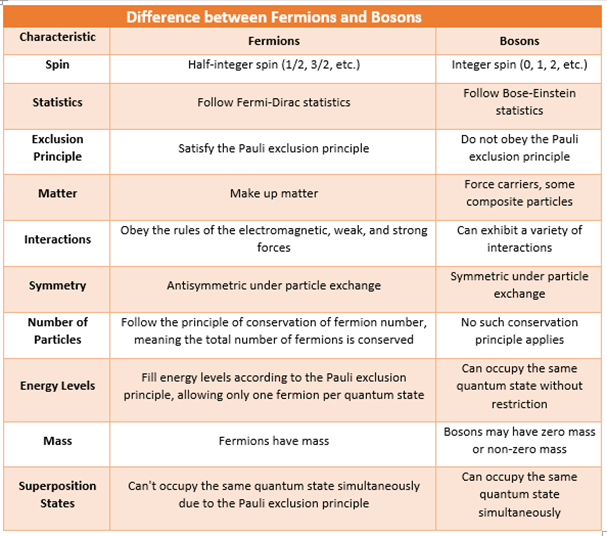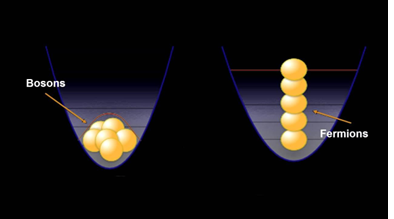Introduction
In the previous chapter, you learned about the standard particle model of quantum mechanics which talks about various types of sub-atomic particles like protons, electrons, etc and their interactions. It is a cornerstone of modern physics and provides a comprehensive understanding of the building blocks of matter and the fundamental forces of nature, except for gravity.
Via quantum theory, these fundamental particles, protons and neutrons, were found to contain quarks, leptons and bosons, which are now considered elementary particles. In this chapter, we will learn about these Elementary particles.
The Elementary Particles
In particle physics, an elementary particle is a subatomic particle that is not composed of other particles. Elementary particles are the basic building blocks of matter and the fundamental entities that make up the universe.
They are the smallest known particles and are not composed of smaller constituents. These particles are considered elementary because they are not believed to have any internal structure or substructure. A particle containing two or more elementary particles is known as composite particle like the protons.

Particles currently thought to be elementary are- The Fermions and The Bosons.
The Fermions
Fermions are a type of elementary particle that follows the Fermi-Dirac statistics, named after Enrico Fermi and Paul Dirac. Fermions are further classified into two main categories: Quarks and Leptons.
| Fermi-Dirac Statistics |
| Fermi-Dirac statistics is a concept used to describe the behavior of a special type of elementary particle called fermions. Fermions include particles like electrons, protons, and neutrons.
In simple terms, Fermi-Dirac statistics tell us how fermions like to arrange themselves in a group. |
Quarks
Quarks are elementary particles that are believed to be the fundamental building blocks of particles such as protons and neutrons, which are known as hadrons. Hence Quarks are matter particles.
| Concept Of Half-Spin |
| The concept of half-spin in particle physics is an intrinsic property of elementary particles, such as fermions. Half-spin refers to the angular momentum of a particle, which is a fundamental property associated with its rotational symmetry.
In classical physics, angular momentum is associated with the rotation or spinning of an object. However, in the quantum realm, the concept of spin goes beyond a literal spinning motion. It is a quantum mechanical property that quantizes the possible values of angular momentum. In the context of half-spin, it means that the allowed values for the angular momentum of a particle are quantized in half-integer multiples of a fundamental unit of angular momentum. |
Quarks are never observed in isolation due to a property called confinement, which means they are always bound together by the strong nuclear force. There are six types or flavors of quarks, each with a different mass and charge:
- Up (u) quark: It has a charge of +2/3e and is the lightest quark.
- Down (d) quark: It has a charge of -1/3e and is the second lightest quark.
- Charm (c) quark: It has a charge of +2/3e and is heavier than the up and down quarks.
- Strange (s) quark: It has a charge of -1/3e and is heavier than the up and down quarks.
- Top (t) quark: It has a charge of +2/3e and is the heaviest known quark.
- Bottom (b) quark: It has a charge of -1/3e and is heavier than the up and down quarks.
Quarks possess a property called color charge, which is associated with the strong nuclear force. They can have one of three color charges: red, green, or blue.
| Color Charge |
| Color charge is a property associated with quarks, which are elementary particles that are believed to be the fundamental constituents of protons, neutrons, and other hadrons. Color charge is a concept used to describe the strong nuclear force, which is responsible for binding quarks together.
The term “color” in this context does not refer to the colors we perceive with our eyes, but rather it is an analogy used to describe the behavior of quarks. Just as primary colors can combine to produce different shades, quarks can have one of three possible color charges: red, green, or blue. These color charges are assigned arbitrary names and do not have a direct connection to visual colors. |
Quarks combine together in various combinations to form color-neutral composite particles known as hadrons. For example, a proton consists of two up quarks (each with a charge of +2/3e) and one down quark (with a charge of -1/3e), resulting in an overall charge of +1e.
Leptons
Leptons are another category of fermions that do not participate in the strong nuclear force. They include particles such as electrons, muons, and tau particles, along with their associated neutrinos. Leptons are characterized by their lepton number, which is a conserved quantum number.
The most well-known lepton is the electron (e), which carries a charge of -1e and is involved in the structure of atoms. The other two charged leptons are the muon (μ) and the tau (τ), which are heavier counterparts of the electron.
Each of these charged leptons is accompanied by its corresponding neutrino: the electron neutrino (νe), the muon neutrino (νμ), and the tau neutrino (ντ). Neutrinos have very little interaction with matter and are electrically neutral.
Significance of Fermions
Quarks and leptons are the building blocks of matter and interact through the fundamental forces in nature, such as the electromagnetic, weak, and strong forces. They play a crucial role in the structure of atoms, the formation of particles, and the dynamics of the universe as we understand it.
The Bosons
Bosons are a class of elementary particles that have integer values of spin, such as 0, 1, 2, and so on. They obey the Bose-Einstein statistics, which describe their behavior in quantum mechanics. Unlike fermions, bosons do not adhere to the Pauli exclusion principle, which means multiple bosons can occupy the same quantum state simultaneously.
Bosons play a crucial role in fundamental interactions and the properties of matter.
| Bose-Einstein Statistics |
| Bose-Einstein statistics is a concept in quantum mechanics that describes the behavior of a special class of particles called bosons. It helps us understand how these particles behave and how they are distributed in different energy states.
Bose-Einstein statistics tells us that bosons have a tendency to gather together and occupy the same quantum state. This means that multiple bosons can be in the exact same energy level, location, and momentum simultaneously, unlike fermions, which cannot. This behavior of bosons leads to interesting phenomena. For example, it allows for the formation of unique states of matter known as Bose-Einstein condensates. In a Bose-Einstein condensate, a large number of bosons come together and occupy the lowest energy state, forming a single quantum entity with fascinating properties. Bose Einstein Condensate is considered as the fifth state of matter besides Solid, Liquid, Gas and Plasma. Bose-Einstein statistics has implications in various fields of physics, such as the behavior of light (photons) and the properties of certain subatomic particles. It helps us understand the behavior of bosons and their interactions with other particles. |
Types of bosons
Gauge Bosons: They are a specific type of boson that mediate the fundamental forces of nature. These elementary particles are force carriers which means that they are the particles responsible for carrying and transmitting the forces between particles that interact through those forces. These are of 3 types:
- Photons: Photons are particles of light and are perhaps the most well-known type of boson. Photons do not possess electric charge and travel at the speed of light. They are responsible for carrying electromagnetic radiation, including visible light, radio waves, X-rays, and gamma rays.
- W and Z bosons: W and Z bosons are particles that mediate the weak nuclear force, one of the fundamental forces of nature. They are involved in certain types of radioactive decay, as well as in interactions that violate the symmetry between matter and antimatter. The W bosons come in two charged varieties, W+ and W-, while the Z boson is electrically neutral.
- Gluons: Gluons are particles that mediate the strong nuclear force, also known as the strong interaction. They are responsible for holding quarks together within protons, neutrons, and other particles that experience the strong force. Gluons themselves carry color charge (analogous to quarks), which is associated with the strong interaction.
Scalar Boson
Higgs boson: The Higgs boson is a particle associated with the Higgs field, which plays a role in giving mass to other elementary particles. Hence, the Higgs boson is the Mass Carrier. It was discovered in 2012 at the Large Hadron Collider (LHC). The Higgs boson has a spin of 0 and is crucial in the framework of the Standard Model of particle physics. We will learn about this particle in detail in next section.
In addition to these well-known bosons, there are other hypothetical or less commonly observed types, such as gravitons (associated with the gravitational force) and scalar bosons (bosons with spin 0). These particles are currently the subject of ongoing research and exploration in the field of particle physics.
Significance of Bosons
Bosons have unique properties and interactions that contribute to various phenomena in the universe. From the transmission of light to the formation of atomic nuclei, their behavior and characteristics are fundamental to our understanding of the physical world

Higgs Boson: The God particle
Particles form the building blocks of everything in the universe, including ourselves. However, during the early stages of the universe, these particles were devoid of mass, and they zipped around at the speed of light. The existence of stars, planets, and life as we know it became possible when particles acquired their mass through an essential field connected to the Higgs boson.
| Really a “God Particle”? |
| The term “God particle” is a popular nickname given to the Higgs boson, but it is important to note that this name is not scientifically accurate or endorsed by physicists. The nickname originated from the title of a book by physicist Leon Lederman, who referred to the Higgs boson as the “God particle” due to its fundamental significance in our understanding of the universe.
The name “God particle” is not meant to imply any religious connotation. Instead, it reflects the idea that the Higgs boson plays a fundamental role in the framework of particle physics. The Higgs boson and the associated Higgs field are important for explaining how particles acquire mass. Its discovery was a major breakthrough in confirming the existence of the Higgs field and validating aspects of the Standard Model of particle physics. |
What is Higgs Boson?
The Higgs boson derives its name from physicist Peter Higgs, who, alongside other scientists, proposed its existence in the 1960s as part of what is now known as the Higgs mechanism. This theoretical framework provides an explanation for how elementary particles acquire mass, shedding light on one of the fundamental properties of the universe.
The Higgs boson is an elementary particle that was discovered in 2012 at the Large Hadron Collider (LHC), a particle accelerator located at CERN, the European Organization for Nuclear Research. Its discovery was a monumental achievement in the field of particle physics and confirmed the existence of the Higgs field, which is associated with the Higgs boson.
According to our current understanding of the natural world, particles are best described as waves existing within a field. An example of this is light, which can be seen both as a wave in the electromagnetic field and as a stream of particles known as photons.
In the case of the Higgs boson, the field came before the particle. The Higgs field was postulated in 1964 as a unique type of field that permeates the entire universe and grants mass to all elementary particles. The Higgs boson, then, is a wave that manifests within this field. The confirmation of the Higgs boson’s existence serves as evidence for the presence of the Higgs field.

Large Hadron Collider: The Machine Which Detected Higgs Boson Particle
The Large Hadron Collider (LHC) is the world’s largest and most powerful particle accelerator. It is located at the European Organization for Nuclear Research (CERN) near Geneva, Switzerland. The LHC was designed to facilitate ground breaking experiments in particle physics, aiming to probe the fundamental structure of matter and the nature of the universe.
| Particle Accelerator |
| A particle accelerator is a scientific instrument that accelerates charged particles, such as protons or electrons, to high speeds, approaching or even reaching the speed of light. Particle accelerators work on the principle of applying electric fields and magnetic fields to propel charged particles and increase their kinetic energy.
Circular accelerators, like the Large Hadron Collider (LHC), use magnetic fields to bend and steer the particles in a circular path, allowing them to pass through the same accelerating structures multiple times. Particle accelerators also have practical applications outside of fundamental research. They are used in medical facilities for cancer treatment using proton therapy, as well as in industrial applications such as material analysis, radioisotope production, and sterilization |
How do particles get their mass?
Mass in particles is acquired through their interaction with the Higgs field rather than possessing an inherent mass of their own. The extent to which a particle interacts with the Higgs field determines its resulting mass.
For instance, photons do not interact with this field and consequently remain massless. However, other elementary particles like electrons, quarks, and bosons interact with the Higgs field to varying degrees, resulting in a range of masses.
The mechanism responsible for endowing particles with mass through their interaction with the Higgs field is known as the Brout-Englert-Higgs mechanism. This mechanism was proposed by physicists Robert Brout, François Englert, and Peter Higgs.
Features of Higgs Boson
As mentioned above, Higgs Boson is a scalar particle carrying mass and is responsible for giving mass to the particles. Some of the key details about the Higgs boson are:
- Spin and Charge: The Higgs boson has a spin of 0, making it a scalar boson. This means it lacks intrinsic angular momentum. It carries no electric charge and interacts weakly with other particles.
- Higgs Field: The Higgs boson is associated with the Higgs field, which pervades all of space. The Higgs field is hypothesized to give mass to other elementary particles. According to the theory, particles acquire mass by interacting with the Higgs field. The Higgs boson is the quantum excitation or particle associated with fluctuations in the Higgs field.
- Discovery: The discovery of the Higgs boson was made possible by the experiments conducted at the LHC. Scientists collided protons at extremely high energies, creating conditions similar to those that existed just after the Big Bang. These collisions allowed the production and subsequent detection of the Higgs boson.
- Properties and Decay: The Higgs boson has a relatively high mass compared to other elementary particles. Its mass was measured to be around 125 GeV/c^2 (gigaelectronvolts per speed of light squared) at the LHC. The Higgs boson has a short lifetime and rapidly decays into other particles.
Significance of Higgs Boson
The discovery of the Higgs boson was significant for several reasons. It confirmed the existence of the Higgs field, providing a crucial piece of evidence for the Standard Model of particle physics. It helped to explain how particles acquire mass and provided a deeper understanding of the fundamental nature of matter.
The implications of the Higgs boson extend beyond the realm of theoretical physics and have implications that may surprise you. This particle plays a crucial role in unraveling the mystery of mass, shedding light on why we, and everything around us, possess mass. It satisfies our innate human curiosity about the origins and evolution of our universe.
The pursuit of the Higgs boson spurred advancements in accelerator and detector technologies, pushing them to their limits. These technological breakthroughs have not only contributed to our understanding of fundamental particles but have also found practical applications in various fields. Industries such as healthcare and aerospace have benefited from the advancements made in the search for the Higgs boson, leading to innovations and improvements in medical diagnostics, treatments, and space exploration.
The impact of the Higgs boson reaches far beyond the confines of particle physics. It touches our lives in ways we may not have imagined, influencing scientific progress and enhancing our knowledge of the universe. By delving into the mysteries of the Higgs boson, we have not only expanded our understanding of the fundamental building blocks of nature but also harnessed new technologies that positively impact various aspects of human life.

 Bharat Bandh 9 July 2025: Over 25 Crore ...
Bharat Bandh 9 July 2025: Over 25 Crore ...
 UPPSC Mains Question Paper 2025: Downloa...
UPPSC Mains Question Paper 2025: Downloa...
 Sukhoi Su-57: Will India Choose Russia�...
Sukhoi Su-57: Will India Choose Russia�...





















